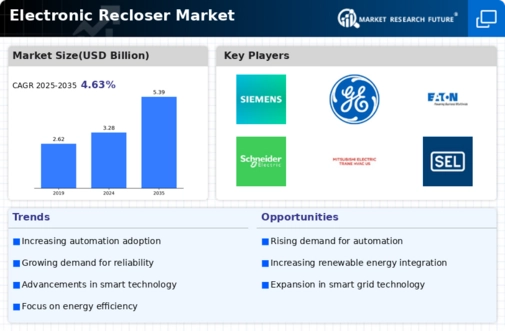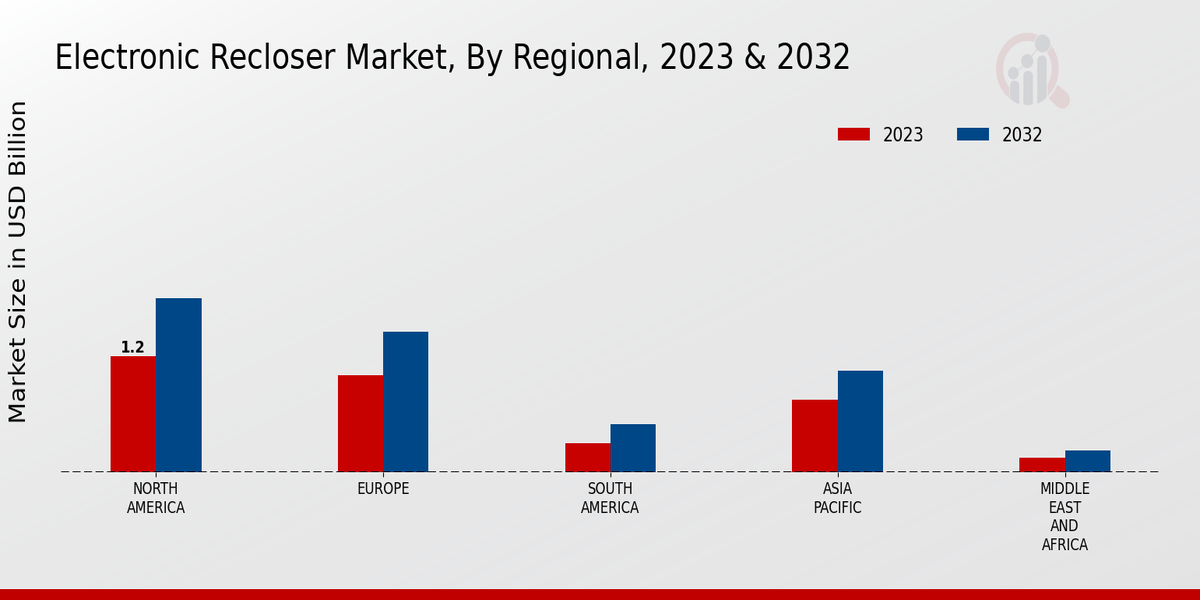Market Growth Projections
The Global Electronic Recloser Market Industry is projected to experience substantial growth in the coming years. With an estimated market value of 3.28 USD Billion in 2024, the industry is on a trajectory towards reaching 5.39 USD Billion by 2035. This growth is indicative of the increasing adoption of electronic reclosers as utilities seek to enhance grid reliability and operational efficiency. The compound annual growth rate of 4.62% from 2025 to 2035 further emphasizes the market's potential as utilities invest in advanced technologies to address the challenges of modern power distribution.
Rising Demand for Reliable Power Supply
The Global Electronic Recloser Market Industry experiences a growing demand for reliable power supply, driven by the increasing frequency of power outages and the need for uninterrupted electricity. As urbanization accelerates, the strain on existing power infrastructure intensifies, prompting utilities to adopt advanced technologies. Electronic reclosers play a crucial role in enhancing grid reliability by minimizing outage durations. In 2024, the market is projected to reach 3.28 USD Billion, reflecting the industry's response to these challenges. Utilities are increasingly investing in electronic reclosers to improve service quality, thereby fostering a more resilient power distribution network.
Government Initiatives and Regulatory Support
Government initiatives and regulatory support play a pivotal role in shaping the Global Electronic Recloser Market Industry. Many countries are implementing policies aimed at enhancing grid reliability and promoting the adoption of smart technologies. For instance, incentives for utilities to upgrade their infrastructure and invest in electronic reclosers are becoming more common. These initiatives not only facilitate the transition to modernized power systems but also align with broader sustainability goals. As a result, the market is poised for growth, with projections indicating a rise to 5.39 USD Billion by 2035, reflecting the positive impact of regulatory frameworks.
Technological Advancements in Grid Management
Technological advancements significantly influence the Global Electronic Recloser Market Industry, as innovations in grid management systems enhance operational efficiency. The integration of smart grid technologies allows for real-time monitoring and automated fault detection, which are essential for effective power distribution. Electronic reclosers equipped with advanced communication capabilities can provide utilities with critical data, enabling proactive maintenance and quicker response times. This trend is expected to contribute to a compound annual growth rate of 4.62% from 2025 to 2035, as utilities increasingly prioritize modernization efforts to meet evolving energy demands.
Growing Investment in Smart Grid Infrastructure
Investment in smart grid infrastructure is a critical factor propelling the Global Electronic Recloser Market Industry. Utilities worldwide are recognizing the importance of modernizing their grid systems to improve efficiency and reliability. Electronic reclosers are integral components of smart grids, providing automated fault management and enhancing overall system performance. As utilities allocate resources towards upgrading their infrastructure, the market is anticipated to expand significantly. The projected growth to 5.39 USD Billion by 2035 underscores the increasing recognition of electronic reclosers as vital assets in the transition to smarter, more resilient energy systems.
Increasing Focus on Renewable Energy Integration
The integration of renewable energy sources into the power grid is a significant driver for the Global Electronic Recloser Market Industry. As countries strive to meet renewable energy targets, the need for reliable grid management becomes paramount. Electronic reclosers are essential for managing the variability associated with renewable sources such as solar and wind. They help maintain grid stability by quickly isolating faults and minimizing disruptions. This trend is expected to accelerate market growth, as utilities seek to enhance their infrastructure to accommodate the increasing share of renewables in the energy mix.











